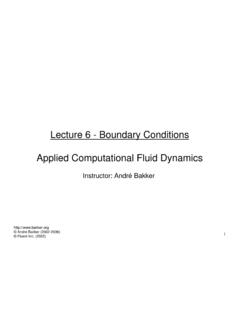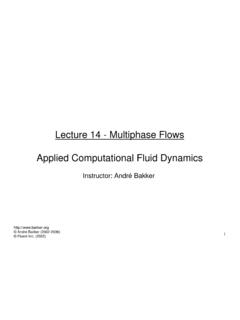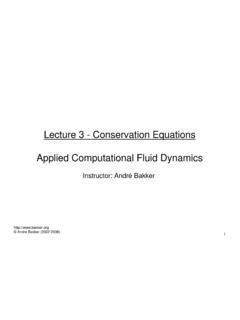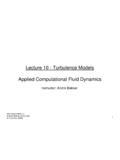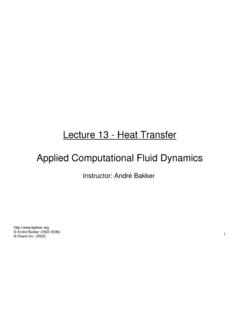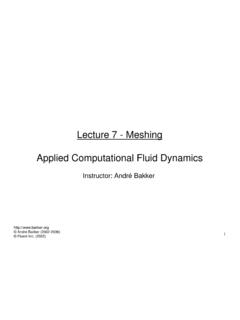Transcription of Lecture 5 - Solution Methods Applied …
1 1 Lecture 5 - Solution MethodsApplied Computational Fluid DynamicsInstructor: Andr Andr Bakker (2002-2006) Fluent Inc. (2002)2 Solution Methods Focus on finite volume method. Background of finite volume method. Discretization example. General Solution method. Convergence. Accuracy and numerical diffusion. Pressure velocity coupling. Segregated versus coupled solver Methods . Multigrid solver. of numerical Methods Many CFD techniques exist. The most common in commercially available CFD programs are: The finite volume method has the broadest applicability (~80%). Finite element (~15%). Here we will focus on the finite volume method. There are certainly many other approaches (5%), including: Finite difference.
2 Finite element. Spectral Methods . Boundary element. Vorticity based Methods . Lattice gas/lattice Boltzmann. And more!4 Finite difference method (FDM) Historically, the oldest of the three. Techniques published as early as 1910 by L. F. Richardson. Seminal paper by Courant, Fredrichson and Lewy (1928) derived stability criteria for explicit time stepping. First ever numerical Solution : flow over a circular cylinder by Thom (1933). Scientific American article by Harlow and Fromm (1965) clearly and publicly expresses the idea of computer experiments for the first time and CFD is born!! Advantage: easy to implement. Disadvantages: restricted to simple grids and does not conserve momentum, energy, and mass on coarse The domain is discretized into a series of grid points.
3 A structured (ijk) mesh is required. The governing equations (in differential form) are discretized (converted to algebraic form). First and second derivatives are approximated by truncated Taylor series expansions. The resulting set of linear algebraic equations is solved eitheriteratively or difference: basic methodology6coextrusionmetal insertcontours of velocity magnitude Earliest use was by Courant (1943) for solving a torsion problem. Clough (1960) gave the method its name. Method was refined greatly in the 60 s and 70 s, mostly for analyzing structural mechanics problem. FEM analysis of fluid flow was developed in the mid- to late 70 s.
4 Advantages: highest accuracy on coarse grids. Excellent for diffusion dominated problems (viscous flow) and viscous, free surface problems. Disadvantages: slow for large problemsand not well suited for turbulent element method (FEM)7 First well-documented use was by Evans and Harlow (1957) at Los Alamos and Gentry, Martin and Daley (1966). Was attractive because while variables may not be continuously differentiable across shocks and other discontinuities mass, momentum and energy are always conserved. FVM enjoys an advantage in memory use and speed for very large problems, higher speed flows, turbulent flows, and source term dominated flows (like combustion).
5 Late 70 s, early 80 s saw development of body-fitted grids. By early 90 s, unstructured grid Methods had appeared. Advantages: basic FV control volume balance does not limit cell shape; mass, momentum, energy conserved even on coarse grids; efficient, iterative solvers well developed. Disadvantages: false diffusion when simple numerics are volume method (FVM)8 Divide the domain into control volumes. Integrate the differential equation over the control volume and apply the divergence theorem. To evaluate derivative terms, values at the control volume facesare needed: have to make an assumption about how the value varies. Result is a set of linear algebraic equations: one for each control volume.
6 Solve iteratively or simultaneously. Finite volume: basic methodology9 Control volumeComputational nodeBoundary nodeCells and nodes Using finite volume method, the Solution domain is subdivided into a finite number of small control volumes (cells) by a grid. The grid defines the boundaries of the control volumes while thecomputational node lies at the center of the control volume. The advantage of FVM is that the integral conservation is satisfied exactly over the control The net flux through the control volume boundary is the sum of integrals over the four control volume faces (six in 3D). The control volumes do not overlap.
7 The value of the integrand is not available at the control volume faces and is determined by control volumePEWNSSWSENENWj,y,vi,x,unesw x y xw xe yn ys11 Discretization example To illustrate how the conservation equations used in CFD can be discretized we will look at an example involving the transport of a chemical species in a flow field. The species transport equation (constant density, incompressibleflow) is given by: Here cis the concentration of the chemical species and Dis the diffusion coefficient. Sis a source term. We will discretize this equation (convert it to a solveable algebraic form) for the simple flow field shown on the right, assuming steady state ()iiiiccu cStxxx +=+ D12 Discretization example - continued The balance over the control volume is given by: This contains values at the faces, which need to be determined from interpolation from the values at the cell ,y,vi,x,ucPcEcNcScWAn,cnAe,ceAs,csAw,cwe e ew w wn n ns s sewnspewnsA u cA u cA v cA v cdcdcdcdcAAAAS dxdxdydy + = + +DDDD,,,: areas of the faces, , ,: concentrations at the faces,,,: concentrations at the cell centers.
8 Velocities at the faces,,,,,,,: velocities at thewneswnesWNES wneswnesWNESWNESA A A Ac c c cc c c cu u u u v v v vu u u u v v v vNotationcell centers: source in cell P: diffusion coefficientPSD13 Discretization example - continued The simplest way to determine the values at the faces is by using first order upwind differencing. Here, let s assume that the value at the face is equal to the value in the center of the cell upstream of the face. Using that method results in: This equation can then be rearranged to provide an expression for the concentration at the center of cell P as a function of the concentrations in the surrounding cells, the flow field, and thegrid.
9 () /() /() /() /e P Pw W Wn P Ps S SeEPewPWwnNPnsPSsPA u cA u cA v cA v cA ccxA ccxA ccyA ccyS + = + +DDDD14 Discretization example - continued Rearranging the previous equation results in: This equation can now be simplified to: Here nbrefers to the neighboring cells. The coefficients anband bwill be different for every cell in the domain at every iteration. The species concentration field can be calculated by recalculating cPfrom this equation iteratively for all cells in the domain.(////)(/)(/)(/)(/)Pn Pe PwwnpeessWw WwwNnnEeeSs SssPc A vA uAxAyAxAycA uAxcAycAxc A vAyS +++++=++++++DDDDDDDDP PWWNNEESSnb nbnba ca ca ca ca cba cb=++++=+ 15 General approach In the previous example we saw how the species transport equation could be discretized as a linear equation that can be solved iteratively for all cells in the domain.
10 This is the general approach to solving partial differential equations used in CFD. It is done for all conserved variables (momentum, species, energy, etc.). For the conservation equation for variable , the following steps are taken: Integration of conservation equation in each cell. Calculation of face values in terms of cell-centered values. Collection of like terms. The result is the following discretization equation (with nbdenoting cell neighbors of cell P):PPnbnbnbaab =+ 16 General approach - relaxation At each iteration, at each cell, a new value for variable in cell P can then be calculated from that equation. It is common to apply relaxation as follows: Here U is the relaxation factor: U < 1 is underrelaxation.
